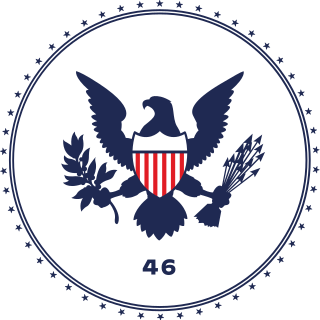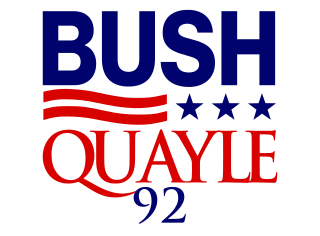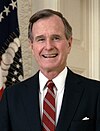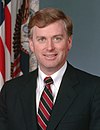During President Jimmy Carter's presidency, he nominated four people for four different federal appellate judgeships who were not processed by the Democratic-controlled Senate Judiciary Committee before Carter's presidency ended. None of the four nominees were renominated by Carter's successor, President Ronald Reagan. Three of the nominees who were not processed were nominated after July 1, 1980, the traditional start date of the unofficial Thurmond rule during a presidential election year. All four seats eventually were filled by appointees of President Ronald Reagan.
In the United States, a presidential transition is the process during which the president-elect of the United States prepares to take over the administration of the federal government of the United States from the incumbent president. Though planning for transition by a non-incumbent candidate can start at any time before a presidential election and in the days following, the transition formally starts when the General Services Administration (GSA) declares an “apparent winner” of the election, thereby releasing the funds appropriated by Congress for the transition, and continues until inauguration day, when the president-elect takes the oath of office, at which point the powers, immunities, and responsibilities of the presidency are legally transferred to the new president.

The presidential transition of Barack Obama began when he won the United States presidential election on November 4, 2008, and became the president-elect. Obama was formally elected by the Electoral College on December 15, 2008. The results were certified by a joint session of Congress on January 8, 2009, and the transition ended when Obama was inaugurated at noon EST on January 20, 2009.

The 1980 presidential campaign of Ronald Reagan resulted in the election of Ronald Reagan and his running mate George H. W. Bush as president and vice president of the United States, defeating incumbent Democratic President Jimmy Carter and Vice President Walter Mondale.

The 1988 State of the Union Address was given by the 40th president of the United States, Ronald Reagan, on January 25, 1988, at 9:00 p.m. EST, in the chamber of the United States House of Representatives to the 100th United States Congress. It was Reagan's seventh and final State of the Union Address and his eighth and final speech to a joint session of the United States Congress. Presiding over this joint session was the House speaker, Jim Wright, accompanied by George H. W. Bush, the vice president.

The 1985 State of the Union Address was given by the 40th president of the United States, Ronald Reagan, on February 6, 1985 — Reagan’s 74th birthday — at 9:00 p.m. EST, in the chamber of the United States House of Representatives to the 99th United States Congress. It was Reagan's fourth State of the Union Address and his fifth speech to a joint session of the United States Congress. Presiding over this joint session was the House speaker, Tip O'Neill, accompanied by George H. W. Bush, the vice president.

The presidential transition of Benigno Aquino III began when he won the 2010 Philippine presidential election. On June 9, 2010, at the Batasang Pambansa Complex, in Quezon City, the Congress of the Philippines proclaimed Aquino as the president-elect of the Philippines, following the 2010 election with 15,208,678 votes, while Jejomar Binay, the former mayor of Makati, was proclaimed as the vice president-elect of the Philippines with 14,645,574 votes, defeating runner-up for the vice presidency Mar Roxas, the standard-bearer of the Liberal Party for vice president.

The presidential transition of George W. Bush took place following the 2000 United States presidential election. It started after Bush was declared the victor of the election on December 12, 2000, when the Bush v. Gore decision by the Supreme Court halted the election recount in Florida, making Bush the victor in that state. The decision delivered him the state's 25 electoral votes, thus giving him a total of 271 electoral votes. This was one more vote than the 270 needed to win the presidency outright, making him president-elect.

Patrick Pizzella is a former American government official who served as the 36th United States Deputy Secretary of Labor from April 17, 2018 to January 20, 2021. He was formerly a member of the Federal Labor Relations Authority appointed by President Barack Obama. He held positions in several agencies during four prior Administrations. In 2019, after the resignation of Alexander Acosta, Pizzella served as the acting United States Secretary of Labor for more than 2 months. He currently serves as the elected Mayor of the village of Pinehurst, North Carolina.

The White House Presidential Personnel Office (PPO), sometimes written as Office of Presidential Personnel, is the part of the White House Office tasked with vetting new appointees. Its offices are on the first floor of the Eisenhower Executive Office Building in Washington, D.C. The PPO is one of the offices most responsible for assessing candidates to work at or for the White House.

The presidential transition of Joe Biden began on November 7, 2020, and ended on January 20, 2021. Unlike previous presidential transitions, which normally take place during the roughly 10-week period between the election in the first week of November and the inauguration on January 20, Biden's presidential transition was shortened somewhat because the General Services Administration under the outgoing Trump administration did not recognize Biden as the "apparent winner" until November 23.

The presidential transition of Bill Clinton began when he won the United States presidential election on November 3, 1992, and became the president-elect. Clinton was formally elected by the Electoral College on December 14, 1992. The results were certified by a joint session of Congress on January 8, 1993, and the transition ended when Clinton was inaugurated at noon EST on January 20, 1993.

The presidential transition of Ronald Reagan began when he won the 1980 United States presidential election, becoming the president-elect, and ended when Reagan was inaugurated at noon EST on January 20, 1981.

The presidential transition of Jimmy Carter began when he won the 1976 United States presidential election, becoming the president-elect, and ended when Carter was inaugurated at noon EST on January 20, 1977.

The presidential transition of Richard Nixon began when he won the United States 1968 United States presidential election, becoming the president-elect, and ended when Nixon was inaugurated at noon EST on January 20, 1969. Nixon had become president-elect once the election results became clear on November 6, 1968, the day after the election. This was the first presidential transition to take place following the passage of the Presidential Transition Act of 1963.

The presidential transition of John F. Kennedy began when he won the 1960 United States presidential election, becoming the president-elect of the United States, and ended when Kennedy was inaugurated at noon EST on January 20, 1961.

The 1992 presidential campaign of George H. W. Bush was an unsuccessful re-election campaign for 1992 United States presidential election by incumbent president George H. W. Bush, who had taken office on January 20, 1989. Bush and incumbent vice president Dan Quayle were defeated by Democratic presidential nominee Bill Clinton and vice presidential nominee Al Gore. Bush, a Republican president and former vice president under Ronald Reagan, launched his presidential bid on October 11, 1991, and secured nomination for his re-election on August 20, 1992. He was challenged in the Republican primaries by former White House Communications Director Pat Buchanan, who received less than one percent of the delegates in the Republican National Convention.

The presidential transition of Dwight D. Eisenhower began when he won the United States 1952 United States presidential election, becoming the president-elect, and ended when Eisenhower was inaugurated at noon EST on January 20, 1953.

Constance Joan Horner is an American businesswoman, known for being the third Director of the United States Office of Personnel Management as well as President Reagan's chief advisor on Federal civil service personnel matters. She was a presidential appointee in the Administrations of President Reagan and President George H. W. Bush.

The presidential transition of Woodrow Wilson began when he won the United States 1912 United States presidential election, becoming the president-elect, and ended when Wilson was inaugurated at noon EST on March 4, 1913.




























